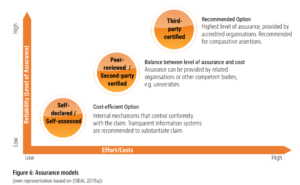To maintain and gain consumer loyalty and trust, many companies are making it a priority to share more detailed information about their products directly with shoppers. Consumers today are particularly concerned with the social and ethical impact of their purchases, such as environmental friendliness.
Earlier this year, the United Nations Environment Programme published its “Guidelines for Providing Product Sustainability Information to Consumers” to provide guidance to the entire consumer packaged goods industry on the best way to share sustainability information with shoppers.
The Guidelines are broken into two parts: Fundamental Principles, which establish minimum requirements that must be met when providing product sustainability information to consumers, and Aspirational Principles, meant to encourage ambition, improvement and sustainability leadership over time. In this article, we will address the 5 Fundamental Principles.
- Reliability: Build your claims on a reliable basis
Sustainability claims must be accurate, robust, and based on a generally accepted methodology. For example, a company should rely on an accepted methodology such as the Global Organic Textile Standard (GOTS) to support its organic t-shirt claim, rather than its own responsible labelling standard that has not been independently assured. For improved reliability, all claims should be third-party certified, as opposed to self-assessed.
- Relevance: Talk about major improvements – in areas that matter
Sustainability claims must provide information on relevant aspects of the product—such as its processes or materials used—that contribute significantly to the product’s sustainability profile. Claims must also exceed what is required by the law, and should not be used to mask areas of poor sustainability performance.
- Clarity: Make the information useful for the consumer
Companies should avoid vague language and share information that helps consumers take action to improve their consumption behavior—for example, how to use a product responsibly and what to do at the end of its life. Consumers must also be able to differentiate between specific product information (“these eggs were produced by free range chickens”) and more general brand information (“our eggs are produced by free range chickens”).
Importantly, a single issue cannot be used to claim that an entire product is sustainable. For example, a product whose workers are not guaranteed fair wages or conditions cannot be labeled as “sustainable,” even if it was produced in an otherwise responsible way.
- Transparency: Satisfy the consumer’s appetite for information, and do not hide
Companies must provide consumers with access to the information underlying a claim, and make it comprehensible. What methods, data sources, or assumptions were involved in reaching a sustainability claim? A balance must be struck between providing detailed information and general, easy-to-understand information.
- Accessibility: Let information get to the consumer, not the other way around
Claims should be clearly visible and readily available when and where the consumer needs it. In addition, companies should communicate claims via several different channels and, when space is limited, provide links or codes to more detailed information.
How does Transparency-One help?
 These 5 Fundamental Principles detail the best practices for communicating product sustainability information for shoppers. Proper sustainability claims do not simply entail placing a short statement or logo on a product; they must be communicated thoughtfully to not only maximize their effectiveness but also demonstrate best practices and respect for consumer knowledge.
These 5 Fundamental Principles detail the best practices for communicating product sustainability information for shoppers. Proper sustainability claims do not simply entail placing a short statement or logo on a product; they must be communicated thoughtfully to not only maximize their effectiveness but also demonstrate best practices and respect for consumer knowledge.
Many of these 5 Principles rely on end-to-end supply chain transparency; the ability to make a product sustainability claim necessarily requires knowledge of that product’s supply chain. Crucially, any sustainability (or other) claim can only be true if it applies to the entire value chain, from source to store. If one component or one supplier is not sustainable, the product as a whole is no longer sustainable.
The Transparency-One solution can help companies achieve all 5 Fundamental Principles by providing the tools needed to identify and map end-to-end supply chains and address the below questions:
- Principle 1: Reliability – What certifications are attached to your products, and what organization (if any) certified them?
- Principle 2: Relevance – What processes and/or materials were used in producing your product, and was this done sustainably? Do your products exceed legal requirements, even below your tier 1 suppliers, in both the countries of production and countries of consumption?
- Principle 3: Clarity – Do you have the information needed to cite specific sustainability claims? What is the social and environmental context for your products? Do my suppliers respect both environmental and social best practices?
- Principle 4: Transparency – Are you prepared to support your sustainability claims with specific data? Have your suppliers provided you with the information—and transparency—needed to do this?
- Principle 5: Accessibility – Do you possess in-depth data on a product supply chain that can be shared with shoppers to extend their knowledge?
By arming themselves with the right tools to map, monitor, and analyze their supply chains, companies can not only ensure product sustainability, but also share this information with consumers in a clear, responsible, and transparent way.










